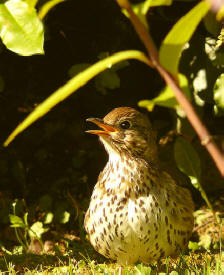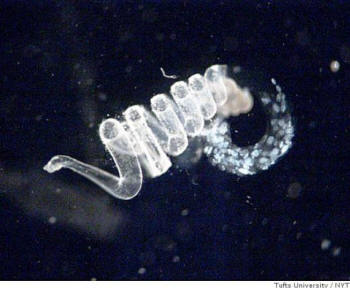Interactions
Photinus ignitus interact with many species, whether it be by
defending their lives from predators or trying to be the most
attractive and fit male. A
 most interesting interaction
that Photinus ignitus fireflies have are with a variety of
predators, including arthropods, birds, amphibians, reptiles,
and fish. Lacking size, strength, and speed (in comparison
with predators), Photinus ignitus fireflies needed to balance
out their weaknesses with a strength in order for survival.
Photinus ignitus gains protection over their main predators,
thrushes and jumping spiders, by having steroidal pyrones known
as lucibufagins (Lewis & Cratsley, 2008). Lucibufagins are
defensive steroids that make Photinus ignitus unpalatable (bad
tasting) to predators (Eisner et. al, 1978). Similar to
other poisonous organisms, the predators that feed on Photinus
ignitus learn to avoid them at each subsequent encounter.
most interesting interaction
that Photinus ignitus fireflies have are with a variety of
predators, including arthropods, birds, amphibians, reptiles,
and fish. Lacking size, strength, and speed (in comparison
with predators), Photinus ignitus fireflies needed to balance
out their weaknesses with a strength in order for survival.
Photinus ignitus gains protection over their main predators,
thrushes and jumping spiders, by having steroidal pyrones known
as lucibufagins (Lewis & Cratsley, 2008). Lucibufagins are
defensive steroids that make Photinus ignitus unpalatable (bad
tasting) to predators (Eisner et. al, 1978). Similar to
other poisonous organisms, the predators that feed on Photinus
ignitus learn to avoid them at each subsequent encounter.
Photinus ignitus are considered lightning bugs because of their
lanterns that luminesce at night. In the
Life History &
Reproduction section of this website, you learn that fireflies,
and more specifically Photinus ignitus, use their bioluminescence to locate and identify their mates during courtship. This is not the only use for the variety of
flashes and glows! The larva use bioluminescence as a
visual cue to predators to indicate that they are unpalatable
and should be averted (Lewis & Cratsley, 2008). As an
adult firefly, the bioluminescence can be used in a different,
interesting way. Under certain circumstances of threat,
such as being caught in a spider web, puddles, or tangles of
grass, Photinus ignitus can emit a variety of flashes that are
unlike those of courtship and mating (Lloyd, 2005). These
flashes most likely communicate a warning for other firefly’s to
stay away.
bioluminescence to locate and identify their mates during courtship. This is not the only use for the variety of
flashes and glows! The larva use bioluminescence as a
visual cue to predators to indicate that they are unpalatable
and should be averted (Lewis & Cratsley, 2008). As an
adult firefly, the bioluminescence can be used in a different,
interesting way. Under certain circumstances of threat,
such as being caught in a spider web, puddles, or tangles of
grass, Photinus ignitus can emit a variety of flashes that are
unlike those of courtship and mating (Lloyd, 2005). These
flashes most likely communicate a warning for other firefly’s to
stay away.
There are also many interactions within the species of Photinus
ignitus. One interaction in particular is that of an
offering and accepting of nuptial gifts. During the
fascinating process of courtship and mating, Photinus ignitus
males provide their female counterparts with nuptial gifts
(Lloyd, 2005). A nuptial gift is a food item or inedible
token that could be used by a female for somatic maintenance and
reproduction. These nuptial gifts can include a variety of
items such as spermatophores (a sperm-containing package),
captured prey, or even an assortment of
 male body parts (Lewis &
Cratsley, 2008). The reasoning behind this contribution is
for the female to use it as nutrients to provision her eggs
(Cratsley, 2004). Some species of fireflies, such as
Photinus ignitus, do not feed as adults. The male nuptial
gifts provide the female with much-needed nutritional value to
supplement her own maintenance in survival and reproduction.
Furthermore, the nuptial gifts will provide other benefits to
the female, such as increasing lifetime fecundity, which is the
potential reproductive capacity of the female firefly (Lewis &
Cratsley, 2008). Interestingly enough, studies have shown
that for Photinus ignitus males, the ability to produce nuptial
gifts, such as spermatophores, declines over each consecutive
mating. This has an impact over the lifespan of male
Photinus ignitus fireflies because they will not be able to
successfully mate as well towards the end of their limited
lifespan (Cratsley & Lewis, 2005).
male body parts (Lewis &
Cratsley, 2008). The reasoning behind this contribution is
for the female to use it as nutrients to provision her eggs
(Cratsley, 2004). Some species of fireflies, such as
Photinus ignitus, do not feed as adults. The male nuptial
gifts provide the female with much-needed nutritional value to
supplement her own maintenance in survival and reproduction.
Furthermore, the nuptial gifts will provide other benefits to
the female, such as increasing lifetime fecundity, which is the
potential reproductive capacity of the female firefly (Lewis &
Cratsley, 2008). Interestingly enough, studies have shown
that for Photinus ignitus males, the ability to produce nuptial
gifts, such as spermatophores, declines over each consecutive
mating. This has an impact over the lifespan of male
Photinus ignitus fireflies because they will not be able to
successfully mate as well towards the end of their limited
lifespan (Cratsley & Lewis, 2005).
Bioluminescent fireflies (which includes Photinus ignitus)
also interact with humans. There are many applications of
firefly chemistry, and here we will look at a few. The
light-producing chemicals taken from fireflies (luciferase) can
be mass produced by injecting firefly genes in another organism,
most likely bacteria, for increased production. As mentioned in
Fun Facts, luciferase is a chemical that can detect levels
of ATP in cell, making it very useful in scientific research,
food safety testing and forensic tests (Zielinski, 2013). In
terms of detecting ATP, NASA has even went as far as using
firefly chemistry in search for life in space (Lloyd,
2005)! The luciferase gene can also dramatically cut down the
time it takes to diagnose a specific strain of
tuberculosis. Since tuberculosis has antibiotic medications
that are strain-specific, time is essential in finding which
strain is causing the dreaded disease, and this has shown to
save many lives (Lloyd, 2005).
